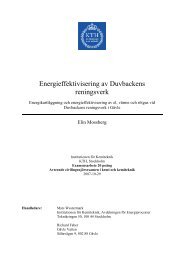Problematik vid höga flöden - Gästrike Vatten AB
Problematik vid höga flöden - Gästrike Vatten AB
Problematik vid höga flöden - Gästrike Vatten AB
You also want an ePaper? Increase the reach of your titles
YUMPU automatically turns print PDFs into web optimized ePapers that Google loves.
RESULTS AND DISCUSSION<br />
Evaluation of the EBPR performance<br />
Three different cases were identified during the study at the WWTP. These cases are<br />
visualized in figure 3 and are linked to the operation with EBPR in relation to the hydraulic<br />
load. At normal operating conditions the anaerobic phosphorus release is high and the overall<br />
P-removal efficiency is around 98 % giving effluent concentrations of phosphorus below 0.3<br />
mg/l. The anaerobic phosphorus mass release rate was 12.6 kg/h during normal conditions,<br />
compared to 2.6 kg/h during high-flow conditions. During high-flow conditions, the overall<br />
P-removal efficiency dropped to about 81 %. After a prolonged high-flow event the recovery<br />
of the P-release was found to be almost instantaneous whereas the P-uptake in the following<br />
aerobic phase demanded a much longer time for recovery. This caused the effluent phosphate<br />
concentration to peak after such a high-flow event, leading to the need for chemical<br />
precipitation. The main reason for this is probably the rapid increase of VFA in the influent<br />
together with a rapid prolonged anaerobic retention time.<br />
PO4-P (mg/l)<br />
Normal conditions High-flow conditions After high-flow conditions<br />
Figure 3. Three different observed cases of EBPR performance as linked to the hydraulic load.<br />
Critical key factors:<br />
The following crucial key-factors were identified as linked to high-flow conditions:<br />
During high-flow conditions.<br />
Lack of organic substrate (VFA) for the anaerobic process.<br />
Occurrence of oxidative compounds (nitrate, oxygen) in the anaerobic reactor.<br />
High levels of oxygen and an excessive aeration in the aerobic reactors.<br />
Occurrence of chemical precipitants in the activated sludge.<br />
After high-flow conditions.<br />
PO4-P (mg/l)<br />
Anaerobic Aerobic Anaerobic Aerobic Anaerobic Aerobic<br />
Rapid increase of influent VFA together with a prolonged anaerobic retention time.<br />
The main reason for the poor performance during high-flow conditions was identified as a<br />
temporary lack of VFA. A correlation between the VFA-feed to the anaerobic reactor and the<br />
phosphate release during different influx flows are plotted in figure 4. Here, a greater VFAsupply<br />
and phosphate release is registrered during low-flow conditions compared to during<br />
high-flow conditions. The anaerobic retention time was in this case shown to be of minor<br />
importance since 100 % of the phosphorus release and 98 % of the TOC uptake occurred<br />
57<br />
PO4-P (mg/l)






